
ARCHIVED PAGE - PLEASE READ!
This page was written by me a long, long time ago. As such the quality of the writing, photography and/or any conclusions I may have come to simply do not stand up to the levels I consider necessary these days.
I do not believe in deleting things outright though as I feel that these pages form something of a time capsule from an earlier stage in my life, and may still be of some interest to folks who have been coming here for a long time. So instead of deleting this page it has been archived.
PLEASE NOTE THAT THIS PAGE HAS BEEN ARCHIVED, AND SHOULD BE CONSIDERED "FOR INTEREST ONLY" AND NOT BE USED FOR ANY OTHER PURPOSE. LINKS, PRICING ETC ARE LIKELY TO BE OUTDATED AND WILL NOT BE UPDATED.
LumaRay FL-12RX. Rating: 92%

LumaRay seem to be making a name for themselves now by creating lights which manage to both look rather cool, and work really really rather well. The FL12RX, launched in Autumn 2006 being no exception. It was a bit of a step away from the path chosen for the original FL series lights in that it was the first to feature any real drive electronics - in this case bringing multiple operating modes into the equation as well.
I admit that I looked upon this "progress" with a little trepidation. One of the things I liked so much about the earlier LumaRay FL series was the simplicity - there was very little to go wrong, and anyone with half a brain cell could use them. Multiple modes can be handy, provided they've been applied correctly. Have LumaRay done a good job of it?
...You're just going to have to read on to find out!
Product Info:
| Manufacturer: | |
| Available from: | Manufacturer's website. - Website no longer active. |
| Price: | $134.95 USD |
| Size: | 21.5 x 5.5cm. |
| Number of lamps: | 12. |
| Lamp Type: | 5mm LED (11x Nichia CS series, 1x red) with custom optics. |
| Peak Beam intensity: | ~820,000 mcd (manufacturers claim). |
| Total Luminous Flux: | Maximum of 86 Lumens (manufacturers claim). |
| Lamp Current: | Unknown - to be measured. |
| Lamp Colour: | White and Red. |
| Body finishes available: | Plastic (GE Xenoy™) - Gunmetal colour. (Also available: White, black, two tone yellow-grey). |
| Battery type: | 3 C-size. Alkaline recommended. |
| Battery life: | Varies by mode - see text below. |
| Switch Type: | Twist bezel on/off and mode switch. |
| Water Resistance: | Waterproof. Submersible to 50 feet. |
| Approximate Beam angle: | Varies by mode - see text below. |
| Notes: | Light is supplied with instruction manual only, no accessories are included. Two year limited warranty (USA Only) on workmanship & materials. |
| Review Date: | 8th February 2007. |
| Related pages: | LumaRay FL-6 (2005 model) Review |
| LumaRay FL-12 (2005 model) Review |
First Impressions:

When you first receive your FL6, you'll know what it is right away - LumaRay are one of only two companies I know that package things in triangular prism shaped boxes - the other thing that comes in boxes of this shape of course being Toblerone chocolates.
Inside the innovative packing you will find, not as you may expect given the holes, something small fluffy and alive, but two sturdy plastic bags (which the vast majority of you WILL need scissors to get into unless you have claw-like fingernails such as mine), containing your brand shiny new flashlight, and its instruction manual.
I'm glad to report that this is one of those packages that you do not have to tear into a million pieces to get into. Just cut through the two pieces of tape holding the box closed (knife or scissors required - trust me), pull the tab out, and unfold. It's a little mini cardboard-engineering marvel in itself.
Now, this bit's important...when you first pick the light up, prepare to be less than filled with confidence - without batteries in, it *feels* cheap and plasticy, quite simply because it weighs virtually nothing. Ignore that though, and wait to make judgments on the feel and balance of the light until you've put the batteries in.
Visually, the first impression you'll get is probably that this is the strangest (and in my opinion one of the coolest) looking flashlight that you've ever laid eyes on. Right from the techno-industrial sort of arrangement around the neck of the light, to the magnifying lens equipped head, it all looks like something right out of Star Wars...no point in dodging the issue...it looks like a light sabre! Especially in the deep gunmetal colour of this unit. The FL12RX is available in a choice of colours unlike the first generation FL6/12, which were only available in this gunmetal finish. White, black and a two-tone grey/yellow colour now make up the rest of the colour options.
These all have their place I think, the existing gunmetal finish was, and still is my favorite, just because it looks so smart. The black is a more purposeful version, designed more with use as an everyday tool in mind. The yellow/grey combination is certainly an interesting one, in my mind fitting in with the somewhat sci-fi styling rather well too, as well as being clearly more aimed at trades where high visibility is the order of the day (I can just see Kaylee pulling it out of her toolbox and using it to look around the engine in Serenity too...or is that just me watching too much Firefly again?). Finally, the new white colour deserves a mention, especially where individuality is concerned. Think about it, when is the last time you saw a white flashlight?
...aside from anything else, I think if in Star Wars, the Storm Troopers had light sabres...they'd look like the white FL6 in this photo does...but that's just me.

(Photograph above taken from a page on LumaRay's website, and is used with permission) - Website no longer active - link removed.
Powering up:
The FL12RX, like all of its predecessors is powered by three ordinary C size batteries (alkaline ones being recommended).
The batteries will last a LONG time in this light, the actual amount varying depending on what mode the light is used in (more on them later). The figures below are taken from LumaRay's website, so your actual findings may vary somewhat - especially depending on the batteries you use (I generally use Duracell's Ultra M3 type, despite the high price).
Mode 1 (Full Power): Up to 8 hours at high brightness, around 400 hours continuous running time.
Mode 2 (Wide Beam): Up to 20 hours at high brightness, around 600 hours continuous running time.
Mode 3 (Red LED only): Up to 6 months(!)
Mode 4 (Spot Beam): Up to 20 hours at high brightness, around 400 hours continuous running time.
Mode 5 (Strobe): Up to 1200 hours continuous running time.
This light does not make use of any regulation circuitry, so as the batteries are used, the light will become gradually dimmer. In my opinion this is actually preferable, as regulated lights have an annoying tendency to go from full brightness to being totally dead in a very short space of time - a light like this however gives you plenty of time to dig out a spare set of batteries before you find yourself plunged in darkness.
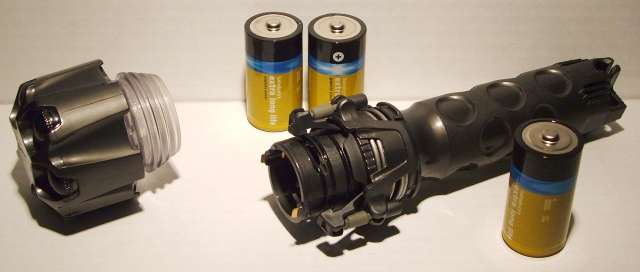
Batteries are not included with the light - presumably to reduce shipping costs as much as anything.
Like its predecessors, the FL12RX has a very unusual and very clever head release system. However, at first glance it's not the most self-explanatory piece of kit you'll ever have encountered. Here's how to get into it.
1. Stand the light on a flat surface (like a desk) with the bezel pointing up. Locate the locking collar - this is the thing with the three rods from the cantilever assembly attached to it - right at the top of the battery tube. Grip this and rotate it anti-clockwise. There's a pretty strong detent when it is the "locked" position. An improvement over the old design, where it tended to rotate of its own accord when turning the light on and off.
2. Get a decent hold of it, and press downward firmly (this is why it's easier to do on a desk - a reasonable amount of force is needed to compress that spring - yes, the one you can see. It is actually a functional component). The head should now lift itself a little if there are batteries installed, if not, while still holding the collar down, lift it off. You can tell how good the waterproofing is at this point, as there's an audible "thump" when you pull it off due to the slight vacuum you've produced in lifting the head up is equalised. This noise caused a very puzzled look from my cat who was watching from the bed at the time. Don't worry if yours does this, it's perfectly normal.
3. Dump out the old batteries if there are any in there. You may have to shake the light to get them out, as LumaRay have intentionally fitted an O-ring to stop the cells falling straight out. This may seem a bit of a faff initially - but trust me, if you've ever dropped C or D batteries on your bare toes when changing them in the dark, you'll realise what a good idea having them unable to fall out actually is! Sometimes the last one can be a pain to get out, some brands seem to take more effort to get out than others, but this can easily be overcome just by shaking the light somewhat more violently than for the other two, it'll drop out eventually.
4. Install three new C size batteries, negative end toward the bottom of the body. There's a decent spring in there, so you can safely drop the cells straight in without worrying about breaking anything.
5. Press the head back on - if it won't fit, rotate it through 30 degrees or so and try again. Very occasionally the switching assembly will line up incorrectly and prevent the head from fitting. This doesn't indicate a fault - just turn the head and try again. The head will click into place audibly when it's right on. It's best not to be looking into the light when doing this, as sometimes it'll switch on when you press the head into place depending on how things line up - and you don't want to be walking around staring at twelve green dots for the next half hour!
6. Rotate the locking ring found in step 1 clockwise until it clicks to lock everything up. Then you're good to go. When you're actually looking at the light, it seems rather more simple than it is to explain.
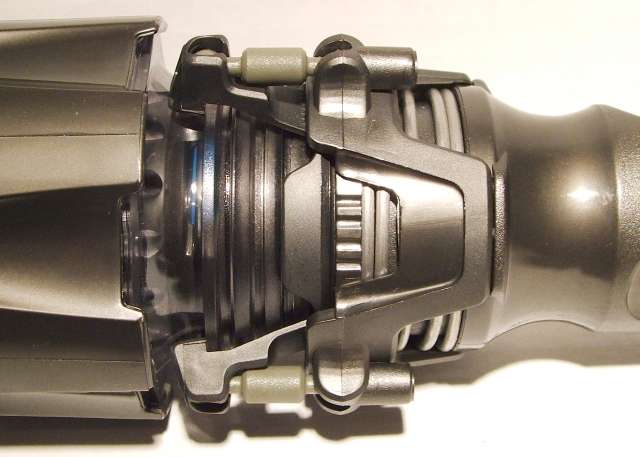
Switching on:
With the original FL12, things were very simple...you turned the head one way, you got light. Turn it the other way, you didn't get light. While that is still the case with the FL12RX, things are a *little* bit more involved.
Switching on is accomplished in the same way - by twisting the head anti-clockwise (assuming you have it facing away from you), and switching off is done by turning it clockwise.
However - if you switch the light on - then briefly off and on again - it will switch into the next mode. There are five of them, and they are as follows.
| Mode 1 | All LED's (apart from the red one) on - both narrow and spot beam at the same time. |
| Mode 2 | Centre LED's (apart from the red one) on - a broad beam for close up work. |
| Mode 3 | Red LED only on - for night vision preservation (though it's a bit bright for that!), or use as a nightlight or similar. |
| Mode 4 | Outer LED's on - a narrow beam for long distance work. |
| Mode 5 | All LED's strobe - designed to attract attention, for use as a distress beacon or in similar applications. |
If you continue switching modes - this sequence simply repeats itself indefinitely.
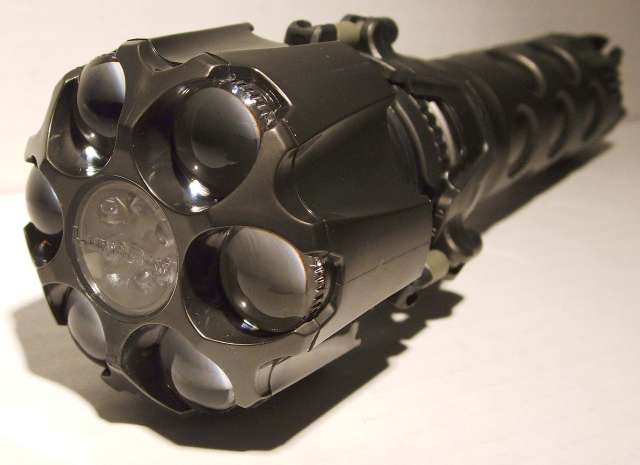
The light can be switched from any mode to the next at any time, some other multimode lights "reset" if they've been left in one mode for more than a few seconds. The only time sensitive thing on this light, is that if it is left off between mode changes for more than a couple of seconds, the sequence will revert to the first mode again.
There is no memory of which mode was last in use (i.e. when you next pick the light up, it will start up in mode 1 - not the last one you used it in). This is my first criticism. When you're fumbling around on the shelf next to the bed at four in the morning having just woken up for whatever reason, you're going to want something that's not hugely bright. This is where the FL12RX doesn't fit the bill...as it always starts up in the brightest mode first. Granted, it does ramp the intensity of the LED's up over 3/4 of a second or so (the way it switches them on in sequence looks really cool by the way - it switches all the inner ones on one after the other, then does the same with the outer ones)...but it's still rather bright. It would make much more sense to me to have the light remember what mode it was last used in, so that I could set it to come on with just the red LED when I grab it in the middle of the night.
I feel that either juggling the modes around so that it goes from dimmest to brightest, or implementing some way to remember which mode you last used would be worthwhile, and would improve the usability of the light...from one point of view anyway...the PLUS side of this is that in its present form, this allows the light to be used in precisely the same way as the original FL12, which is a good thing too...so isn't necessarily a bad thing.
The sequence is one thing that some people will like, and some won't. The ideal solution would be to have a way to select which mode appears first, but that would of course be rather tricky to engineer, and would in the long run probably make the light more difficult to use.
Best just keep it as it is I think.
Performance:
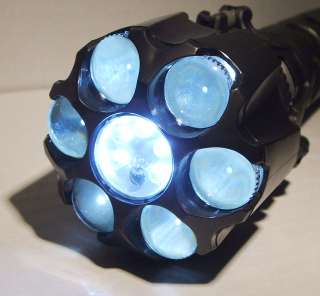
None of the FL series of flashlights have been slouches where performance is concerned (the original FL12 in particular surprising a lot of people), and this is no exception. As LED technology has moved on, so have the LED's that LumaRay have picked for the FL series of lights. LumaRay have used Nichia NSPW500CS LED's in this flashlight, which were the brightest 5mm LED's on offer from that maker at the end of 2006.
Make no mistake - this thing is bright. Bright enough to be useful too.
The first white LED flashlights were interesting, expensive, but not hugely useful things. Bright enough to keep on a keychain for finding the keyhole in the car door with, or to hunt for the change that's disappeared under the drivers seat (or if you're like me, to find that socket you just dropped down the side of the engine in your Lada Niva, and you know is now sitting on the sump guard somewhere!). They weren't much use for actually walking around with though, for a long time that area being the sole territory of Luxeon Star LED's, or incandescent flashlights. Oh how things have changed!
This light can quite definitely give a number of Luxeon Star based LED flashlights a run for their money, and equal - even out perform a number of common incandescent flashlights made by a very well known flashlight company (no names, no lawsuits!).
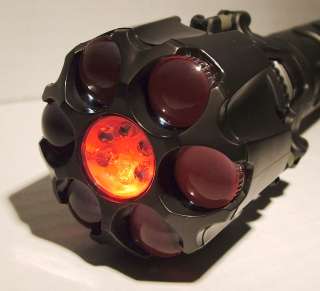
The real bonus with the lamps used in this light are that in conjunction with the different operating modes, it makes them so flexible. With a single 3W Luxeon Star LED, you've got one type of beam, one colour and (usually) one power level. Here though, you have effectively three power levels, three beam types, and a strobe function. That's pretty good going I reckon.
The red LED I find serves particularly well as a nightlight, providing enough light to act as a comforting presence in a children's bedroom, and a battery life measured in months makes it quite an economical proposition for it to be used as such too.
Beam Profile:
(All images below taken from roughly 1.5 metres)
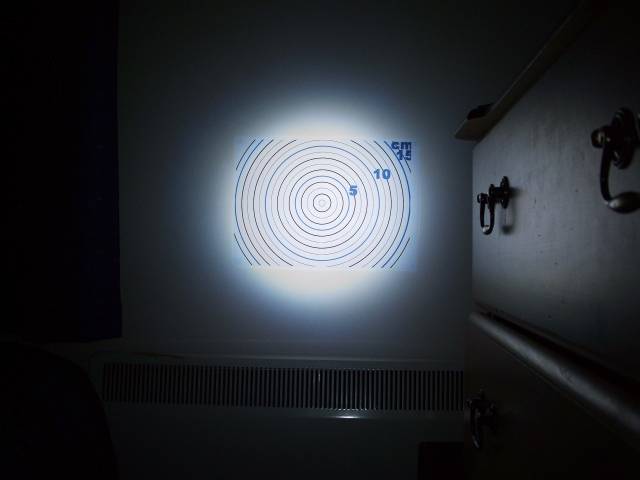
Mode 1 (all white LEDs lit).
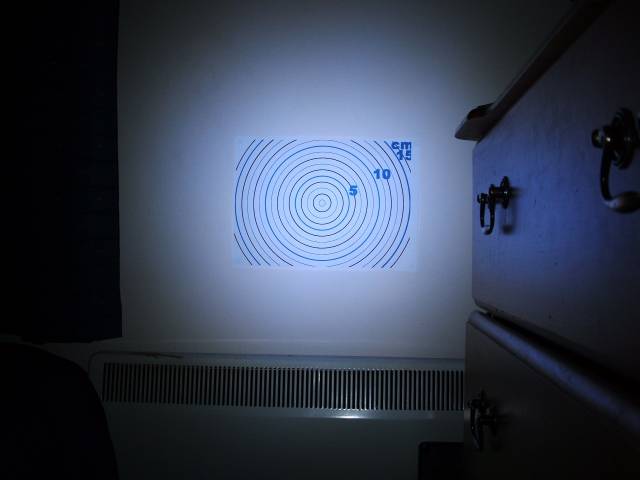
Mode 2 (Centre white LEDs only lit).
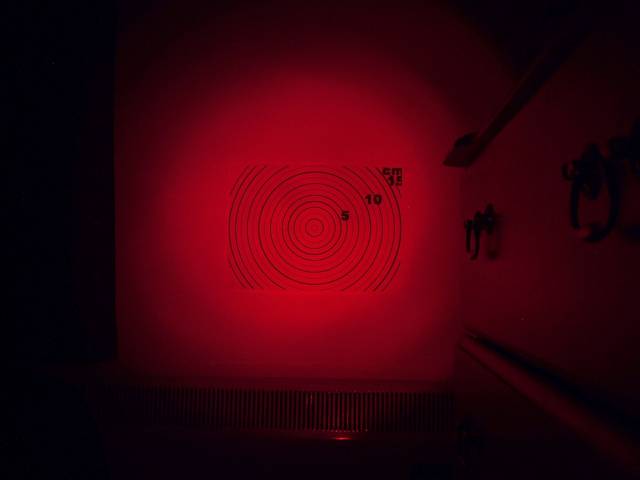
Mode 3 (Red LED only lit).
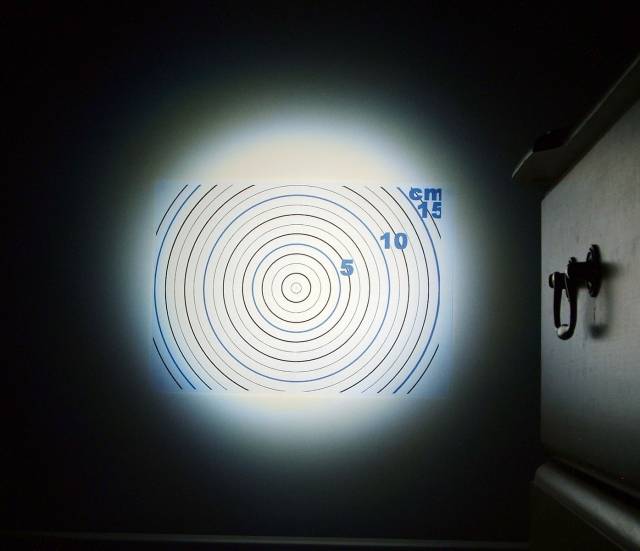
Mode 4 (Outer LEDs only lit)
Unfortunately, I've no real way of catching the strobe mode in action. The frame rate of my camera in video mode isn't fast enough to catch it.
The red LED plays havoc with JPEG image compression unfortunately - sorry about that!
Lamps:

The FL12RX has twelve lamps - all 5mm LEDs. These are not the wimpy little things you see behind the lights on your video recorder though (despite being based on the same technology), these are a whole different ballgame. These are all Nichia CS series LED's, which (as of December 2006) were the brightest LED's of their type that you could get (the red one, which is a slightly more conventional high brightness type excepted).
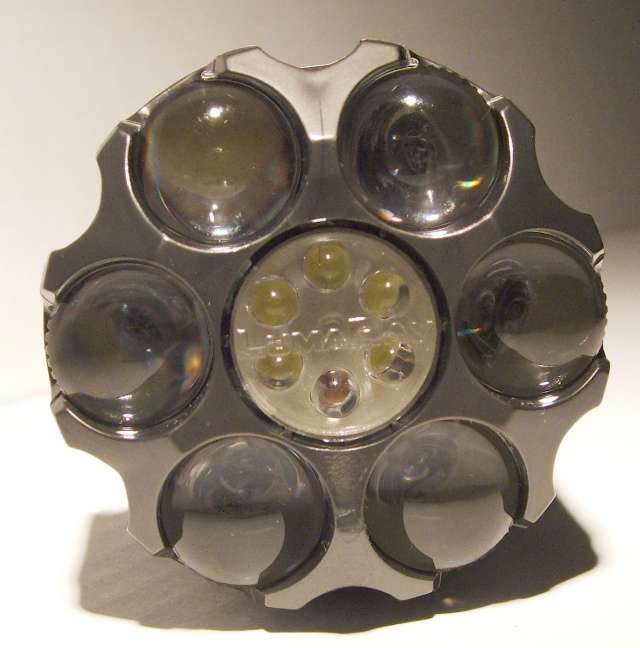
LED's suit themselves very well to portable lighting applications such as this thanks to their low voltage requirements, and high efficiency compared to their incandescent equivalents. In addition to that, they produce very little heat, and are almost completely impervious to damage through shock or vibration. If treated properly from an electrical point of view, they should have very, very long lifetimes - in the order of tens of thousands of hours, if not more. For this reason, there is no provision made on this light for replacement of the lamps.
Ergonomics:

Well, we've proved that the FL12RX performs well, is a very flexible tool, is pretty simple to use, and it looks cool...but how is it to actually use? Has someone gone to such lengths to make it look good, and totally forgotten about the ergonomics?
As it turns out, no they haven't. Far from it in fact.
As you can see in the photograph above, the FL12RX fits nicely into a hand of average size, it's comfortable to hold, easy to hold onto thanks to the large "dimples" in the body and the matt texture of the grip. It is also very well balanced - the point of balance being right on that curved bit where my thumb in the photo is.
The groves in the head both act as grip aids for switching the light on and off, and also to act as an anti-roll device - they serve both functions very effectively. Turning the light on with the thumb of the hand holding it is just about possible - but mighty hard work. I'd say that two handed operation is required realistically. Unless you want a sore thumb anyway.
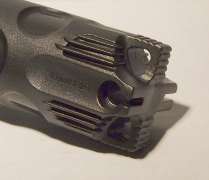
Provision is made for attachment of a lanyard to the tail end of the body, while also allowing the light to stand on its tail unaided on any reasonably flat surface. It does rock a little, but seems to be stable enough. Very handy when using the light in "ceiling bounce" mode to light a room - something I do quite often.
If you own one of the first generation FL series lights, you will note that the tailcap on the FL12RX has been redesigned from the original rather elaborate design. While this may not look quite as cool...it's just as functional, a lot easier to make no doubt, and less prone to tearing pockets to bits when you're trying to get the light out of them.
Durability Department:
If there's a single word that sums up the FL12RX (or any of the series for that matter), it's durable. The casing, while it may be very light, and (at least until you stick the batteries in) and not actually feel all that indestructible, is actually made of Xenoy™ (a highly durable polycarbonate material made by GE). This high quality material choice continues to the internal structure of the light. Many of the contacts which in any "ordinary" flashlight would have been made of thin, cheap copper, are in here made of substantial stainless steel. Not only was the casing of this light designed to take a beating without falling apart, it was designed to continue functioning while taking said beating.
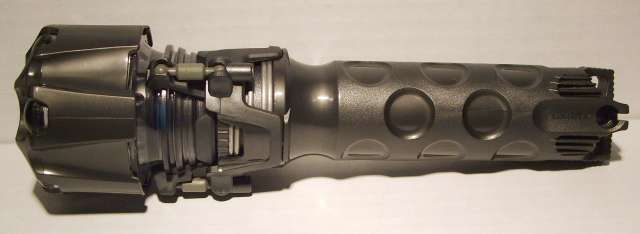
Needless to say, the usual tests were shrugged off with utter impunity. Dropping the light to a wooden floor from desk height resulted in a loud bang...and continued operation without anything more than a flicker. Throwing the light across the room from waist height (to simulate dropping it while running) left a dent in the wall (oops...), and the same result...the light sitting there shining away quite happily as if to say "That all you've got then? Gonna have to do better!" As it turned out, I did to better later the same evening, when it escaped from my pocket while running down the stairs. All the way down the centre of the stairwell from the second floor to a thinly carpeted concrete floor...all this drop managed to do was switch it on. Tough bit of kit this.
The manual states that the light is waterproof to 50 feet...so it should come as no great surprise that being left at the bottom of the bath for 24 hours didn't result in a single drop of water getting into the light. To ensure this remains the case, there are no less than two O-rings fitted to the head of the light, these should be periodically lubricated with a silicone based lubricant. Note that not too much should be used, a couple of drops is more than sufficient. If you wish the head to be slightly easier to turn, one of the O-rings can be removed - this will however reduce the level of water resistance somewhat. Even with just the one O-ring fitted, the light should still be more than capable of surviving being caught outside in the rain when you're walking the dog.
Should the light fall apart within the first two years of its life of its own accord (though this is so far from likely that it's almost laughable - trust me, my original FL12's been through the wars a fair bit, and still works like the day it was made), there's a warranty on the workmanship and materials used.
Overall:
As I said at the start of this page, I approached the idea of a multimode LumaRay with a little trepidation. LumaRay appear to have pulled it off though! I've encountered a number of lights featuring multiple modes of operation, and a good number of them have proved to be really rather fiddly to use, more often than not with me ending up in completely the wrong mode, and/or spending what seems like forever in the dark trying to find the mode that I'm after.
LumaRay have continued with one of their main plus points, they've kept the light easy to use. If you just switch it on and switch it off - it works just like the original FL12 did. However, all those extra modes are tucked away there in case you ever need them.
It's a very, very good light. Granted, it's rather pricy for a piece of lighting equipment...but on the same count, it's also a lot better engineered than your usual piece of lighting equipment. While you might pay £10 for a 3C light at your local market, and use it for six months, before it gave up the ghost...this thing will serve you, every day, for years on end.
Pros:
+Feels great in the hand
+VERY Long battery life
+Uses cheap easy to find batteries
+Water resistant
+Fairly light for its size
+Highly durable
+Glow-in-the-dark locator is a useful feature, and works.
+Modes are actually different enough to each other to be useful.
Cons:
-None.
Niggles:
>There is some light which can be seen leaking out of the back of the bezel when in operation, some people may find this objectionable.
>Switch can be somewhat hard to operate one handed if you have weak hands.
>Mode selection starts on high - this isn't the way some people like to see them arranged - a matter of personal preference I think though.
Ratings:
Beam Quality: 10
Build Quality: 10
Battery Life: 10
Durability: 9
Value: 7
Overall: 46/ 50 = 92%
Many thanks to Ed at LumaRay for providing this light for review!
Long Term Testing:
6th April 2025: Removed a number of dead links to manufacturer's website as they sadly no longer appear to be operating.
3rd August 2009: Updated some of the formatting on this page. Glad to report that this light is still working perfectly.
8th February 2007: Presently working on the review process - but uploaded some photos for your viewing. A few bits of text are here, as they will be reused from the FL-6 review, as mechanically the lights are identical.
24th February 2007: Just need to snap a few photos at longer range, and re upload the beam shot of the red LED mode. Other than that, I consider this page complete.
5th January 2021: Page retired and moved to Site Archive.
28th April 2023: Revised Statcounter code to allow for HTTPS operation.